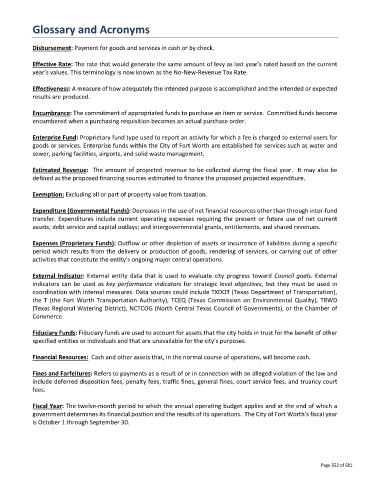Page 552 - FortWorthFY22AdoptedBudget
P. 552
Glossary and Acronyms
Disbursement: Payment for goods and services in cash or by check.
Effective Rate: The rate that would generate the same amount of levy as last year’s rated based on the current
year’s values. This terminology is now known as the No-New-Revenue Tax Rate.
Effectiveness: A measure of how adequately the intended purpose is accomplished and the intended or expected
results are produced.
Encumbrance: The commitment of appropriated funds to purchase an item or service. Committed funds become
encumbered when a purchasing requisition becomes an actual purchase order.
Enterprise Fund: Proprietary fund type used to report an activity for which a fee is charged to external users for
goods or services. Enterprise funds within the City of Fort Worth are established for services such as water and
sewer, parking facilities, airports, and solid waste management.
Estimated Revenue: The amount of projected revenue to be collected during the fiscal year. It may also be
defined as the proposed financing sources estimated to finance the proposed projected expenditure.
Exemption: Excluding all or part of property value from taxation.
Expenditure (Governmental Funds): Decreases in the use of net financial resources other than through inter-fund
transfer. Expenditures include current operating expenses requiring the present or future use of net current
assets; debt service and capital outlays; and intergovernmental grants, entitlements, and shared revenues.
Expenses (Proprietary Funds): Outflow or other depletion of assets or incurrence of liabilities during a specific
period which results from the delivery or production of goods, rendering of services, or carrying out of other
activities that constitute the entity's ongoing major central operations.
External Indicator: External entity data that is used to evaluate city progress toward Council goals. External
indicators can be used as key performance indicators for strategic level objectives, but they must be used in
coordination with internal measures. Data sources could include TXDOT (Texas Department of Transportation),
the T (the Fort Worth Transportation Authority), TCEQ (Texas Commission on Environmental Quality), TRWD
(Texas Regional Watering District), NCTCOG (North Central Texas Council of Governments), or the Chamber of
Commerce.
Fiduciary Funds: Fiduciary funds are used to account for assets that the city holds in trust for the benefit of other
specified entities or individuals and that are unavailable for the city’s purposes.
Financial Resources: Cash and other assets that, in the normal course of operations, will become cash.
Fines and Forfeitures: Refers to payments as a result of or in connection with an alleged violation of the law and
include deferred disposition fees, penalty fees, traffic fines, general fines, court service fees, and truancy court
fees.
Fiscal Year: The twelve-month period to which the annual operating budget applies and at the end of which a
government determines its financial position and the results of its operations. The City of Fort Worth’s fiscal year
is October 1 through September 30.
Page 552 of 581

